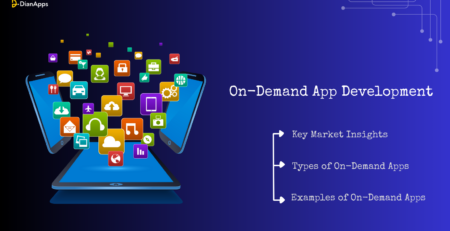The Ultimate Mobile App Launch Checklist For 2024
Launching a mobile app needs careful planning to avoid issues and ensure a smooth entry into the market. The pre-launch phase is when you fix potential problems and fine-tune your app for the best performance.
In this checklist, quality assurance is key. It means making sure your app gives users a great experience. Even small problems can hurt how people see your app, so paying attention to details is crucial in a competitive app world.
For startups going into the app market, it’s vital to go beyond the basics. Your app needs to do more than just get downloaded; it should connect with users. With about 299 billion app downloads globally each year, standing out is a must.
This mobile app launch checklist is your complete guide, giving you important steps to have a successful app launch. Following these steps gets you ready, positioning your app for success in a crowded app market.
To prevent any last-minute headaches, we’ve compiled a list of crucial steps for launching an app. This checklist will help ensure a successful campaign and make your app stand out in the crowded app market.
Launching Your App the Right Way: A Top 10 Checklist
Pre-Launch Checklist
1. Understanding Your Audience & Analyzing Competitors
Before you launch your app, it’s crucial to know your audience and competitors. This is a key rule in the top app launch checklist to create effective marketing strategies.
- Who are the people you want to use your app?
- What makes people choose your app over others?
- Why is your app better than what’s already out there?
Answering these questions is essential for your app’s marketing. It ensures that your brand is clear and effectively communicates with your audience in just a few words.
Understanding your audience and competition is like a secret weapon in the world of mobile app development.
2. Engaging Your Existing Community & Influencers
Connecting with others in your niche is made easy by various platforms, forming a community of like-minded people. Keeping an eye on the market and existing communities is crucial for discovering new opportunities. This isn’t a last-minute app checklist item; it should be a priority.
Create a list of influencers, nurture relationships, and pitch to them as part of your app pre-release checklist. This increases the chances of getting featured when your app launches, especially within the mobile app developers’ community.
3. Securing Domain & Social Media Handles
A vital step in the checklist is securing the app’s domain, like www.app-name.com, aligned with the app’s description and name. Completing the landing page and finalizing social media handles are crucial pre-launch tasks for a smooth market entry.
Establishing a robust online presence is pivotal for any mobile app development company to effectively target the market audience. The age bracket plays a significant role in online marketing strategies due to its specific targeting.
4. Executing a Beta Release
Before launching your app in beta mode, ensure a feedback loop is in place for data gathering and user communication, enhancing the app’s quality and customer interaction. Plan the beta launch with the mobile app deployment checklist, considering essential deployment points for a near-final app version. This allows adjustments based on real-world feedback before the official launch.
Many developers now prefer the MVP (Minimal Viable Product) approach, launching an app with essential features to get it to market quickly. This strategy ensures an early market presence and allows for regular updates based on feedback and pre-established plans in the evolving landscape of mobile app development.
5. Adhering to Submission Guidelines & Defining Success Metrics
Before launching your app, carefully follow the app store submission guidelines of platforms like Apple and Google to avoid potential rejections. After reading the guidelines, utilize Google and Apple App store optimization ASO checklists to ensure your app meets all criteria. This step is crucial in understanding “how to launch an app” effectively and avoiding rejection.
Post-guideline adherence, focus on the metrics that contribute to an app’s success. Understand what makes an app go viral, why certain apps succeed, and identify unique features that contribute to success. Consider factors like user loyalty and monetization to gauge the app’s potential success before launch. This proactive approach provides insights on how to measure and enhance your app’s chances of success.
6. Preparing a Press Kit Directory
Ensure your app gets the attention it deserves by making it accessible to journalists, bloggers, and researchers. Create a Press Kit directory containing comprehensive information like app descriptions, screenshots, logos, promo videos, and social media details.
This centralized resource simplifies the process for influencers to quickly grasp essential points about your app, facilitating easier decision-making and sharing. By providing a single library of information, you make it convenient for anyone interested in covering or promoting your app to access key details without scouring the internet.
7. Crafting a Compelling Lock Page Description
Before the official launch, gather feedback from online discussions, landing page tests, and beta versions. This step in the app launch checklist is crucial for making necessary tweaks and improvements before the final release. By collecting brief feedback, you can ensure that your app is refined and optimized to achieve prominent results. This approach is valuable for any app development company striving to deliver a polished and well-received product to the market.
8. Integrating App Software Seamlessly
After optimizing the app based on beta suggestions, the next crucial step is measuring and fostering its growth. This involves integrating the app with essential software needed in the market. It’s imperative to handle this during the pre-launch phase, as introducing a new version later could impact the overall app rating. This strategic approach is vital for any mobile app development process, ensuring that the integration and growth aspects are well-managed from the beginning.
Launch Checklist
1. Publishing on the Play Store
As the day to launch your app in the market approaches, it’s crucial to revisit the app store submission checklist and ensure your app is optimized accordingly. Consider this a last-minute revision and submit your app at least a week before the planned launch date.
The approval process from the app store takes time, and this strategic approach simplifies the overall process, aligning with guidelines and the scheduled launch date. This careful preparation is an essential step in the process of mobile app development, ensuring a smooth and timely entry into the market.
2. Notifying Audience and Influencer
Once your app gets the green light from Google and Apple stores, it’s time to celebrate and spread the word proudly. Reach out to your contact list, which includes your target audience and influencers, through emails to inform them about the app’s release. Generate excitement among them, encouraging them to download and engage with the app.
Utilize press lists and get in touch with influencers who have the potential to share your app in the market. Since you’ve already initiated conversations with these influencers during the app launch checklist phase, leverage those relationships. Reconnect with them, reignite the connection, and inspire them to not only use the app but also share it for added coverage. This proactive communication ensures a strong start for your app in the market.
3. Dashboard Design
In the midst of detailed work, it’s easy to overlook the broader picture. Take a moment to pause and set up a designated space for tracking Key Performance Indicators (KPIs) using a dashboard. This dashboard becomes a visual representation of the metrics critical for app success, fostering accountability and goal orientation.
Essential metrics, such as total download count, app store rank, monthly downloads, all-time rating, and last updated, are consolidated on this dashboard. This compilation offers a clear and comprehensive snapshot of the app’s performance. Incorporating this practice is a valuable step in ensuring that the smaller tasks align with the overarching success of the app.
Additionally, collaborating with an experienced app design company can enhance the visual appeal and user experience, further contributing to the app’s success.
Post-Launch Checklist
1. User Engagement & Feedback
In beta testing, the feedback tool proved invaluable, addressing major app errors and opening a channel for customer communication. Monitoring the app early on, resolving bugs promptly, and releasing updates are crucial for customer satisfaction. The initial 30 seconds are decisive, so prompt updates can captivate users. During the first week, identify potential regular users and focus on retention. Proactive, respectful communication enhances user experience, fostering a positive connection. A Digital Marketing Services Company can aid in crafting effective communication strategies for user retention.
2. Reviews and Ratings Encouragement
Encourage customers to share their feedback through ratings and reviews, a crucial step in the app launch checklist. Transparency is key; warn users if the app may not meet their expectations. Genuine reviews enhance trust, increasing the conversion rate. Don’t hesitate to request reviews from loyal customers. Ratings are pivotal in app stores; for example, the Apple App Store requires at least five ratings to calculate the average. A genuine approach fosters credibility and visibility, addressing conversion challenges.
3. Store Rank Monitoring
The app store launch checklist emphasizes the critical nature of an app’s ranking from day one. Factors like retention, downloads, reviews, and ratings influence this ranking. Unlike established apps, a new app is highly susceptible to the impact of a single negative review or a slow day, akin to an “App Titanic” scenario. During the initial week, the app experiences fluctuations before stabilizing. Skillfully managing these factors, along with effective Search Engine Marketing services, is essential for securing a prominent rank in the app store.
4. Release First Update
After the initial app release, promptly launch the first update within a few weeks, incorporating user feedback and addressing pending changes. Demonstrating a commitment to customer feedback builds loyalty, showcasing a dedication to quality improvement. Aim for monthly updates to ensure bug-free releases, positively impacting app ratings. Regularly measure performance, adding metrics to the dashboard for continuous rank tracking—a crucial step in the mobile app deployment checklist. This routine ensures a proactive approach to maintaining app quality and user satisfaction.
5. Customer Requirements Prioritization & Road Map Lock
Prioritize customer feedback in your app store launch checklist. Understand the frequency of user issues and gauge their interest in specific features. This insight guides a roadmap for long-term product development, helping determine the urgency of feature additions and bug fixes. By setting priorities based on customer needs, you enhance user experience, attract audiences, and bolster quality assurance, ensuring your app evolves to meet user expectations and industry demands.
6. Incentivize continuous usage
After launching your app, retaining customers is key. Foster engagement with new content, personalized experiences, referrals, and custom gifts designed for your app users. Ensure your app is easily shareable with a unique selling point for effortless sharing, simplifying the download process. Prioritize push notification optimization to prevent user dissatisfaction and uninstallations—integrate these steps into your mobile app deployment checklist to stimulate organic growth and maintain sustained user interest.
7. Evaluate app performance
For mobile app developers, consistently assessing and refining apps is crucial. Before adding suggested features, conduct surveys to gauge customer interest and release beta versions for satisfaction assessment. Keep a keen eye on app ratings, reviews, updates, and retention rates to grasp customer preferences and optimize app performance. This practice is integral for a mobile app-building company committed to delivering user-centric and high-performing applications.

Mistakes to Avoid Before & After a Mobile App Launch
1. Not Paying Attention to Social Media Marketing
Social media marketing Services (SMM) can prove to be powerful for brand humanization and quick communication. Effective SMM builds customer relationships, showcases brand identity, and reaches potential customers. Neglecting SMM can result in missed leads and decreased engagement.
2. Not Giving Rewards to Users for Promotions
Incentivize user behavior through rewards and bonuses. Users appreciate incentives for completing tasks or making purchases within your app. This strategy promotes user engagement, encouraging users to rate your app or product and share positive experiences.
3. Not Following the Parameters
Regularly track app parameters like daily and monthly users, average revenue per user, etc. Monitoring popular functionalities and addressing user issues helps in continuous improvement, ensuring sustained user growth and an appealing app experience.
4. Neglecting Customer Support
Excellent customer support is vital post-app launch. Automated tools enhance service, but personalization matters. Treat each customer with care, invest time in researching support possibilities, and address customer concerns promptly to build trust and loyalty.
5. Not Paying Attention to Early Bug Fixes
Establishing a set release date generates pre-launch buzz. Proactively promote your app in advance to cultivate anticipation. Address early bug fixes promptly, leveraging the app description as a marketing tool to positively engage users.
Additionally, it’s important to choose the best mobile app development platform to ensure optimal performance and user experience.
6. Lack of Proper Push Notifications
Finding the right balance with push notifications is crucial. Too many can annoy users, while too few may lead to user disinterest. Focus on delivering timely and relevant in-app and push notifications for optimal engagement without overwhelming users.
7. Not Releasing Updates
Regular updates maintain app relevance, show developer commitment, and improve user experience. Addressing issues, enhancing functionality, and introducing new features through updates keep the app interesting and trustworthy over the long term.
Over to you,
Successfully launching an app goes beyond technical expertise. It requires a robust product, technical excellence, optimization, and effective marketing. Our mobile app launch checklist unravels the best practices in development, testing, app store optimization, and marketing strategies to help your app thrive in a competitive landscape. These insights aim to guide you in creating a standout product for successful market penetration.
Struggling to kickstart your idea? We’re a leading mobile app development company in the USA, equipped with a skilled team. Let us assist you in strategizing, designing, and building your mobile app. Contact us for a free consultation and let’s bring your app idea to life.




